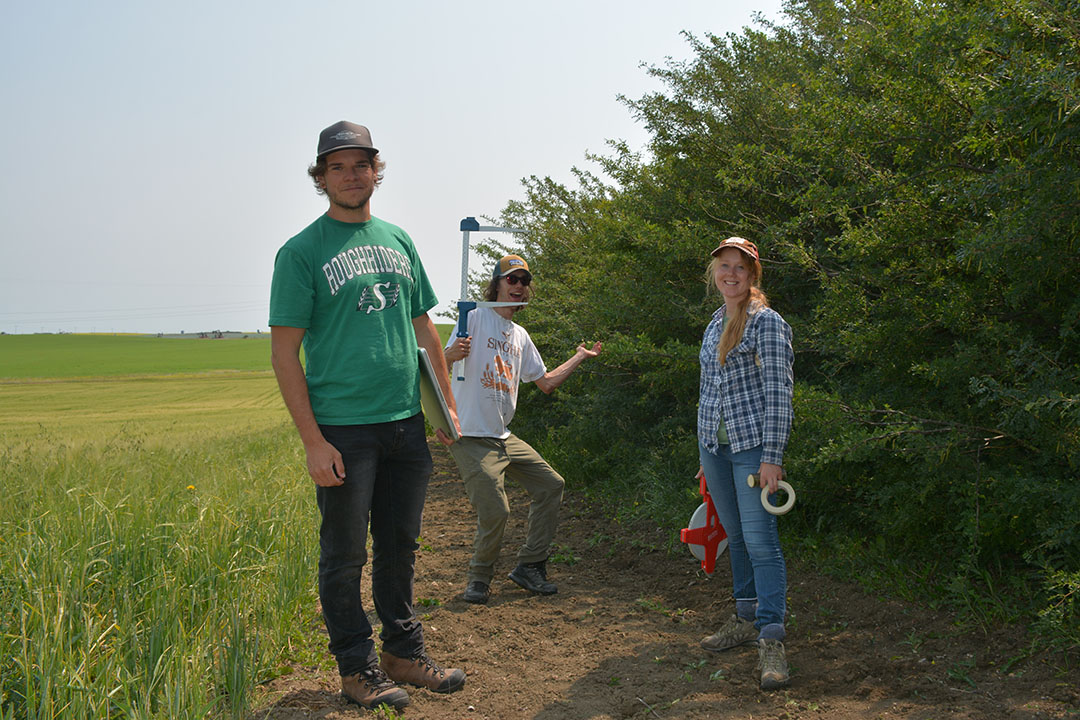
New USask app promotes potential economic value of planting carbon-storing shelterbelts
A unique new app developed by University of Saskatchewan (USask) researchers led by Colin Laroque (BSc'93) offers agricultural landowners tailored information about the carbon offset value of planting shelterbelts—a tool that could help reduce the carbon footprint of farming and potentially put a little extra money in farmers’ pockets.
By KIRA GLASSCOCK AND USASK RESEARCH PROFILE AND IMPACT“People tend to focus on the negative environmental aspects of farming such as the greenhouse gases emitted from vehicles, fertilizers and grain transportation, when in fact much of this impact can be offset through planting trees. In fact, with shelterbelts on their land, many farmers probably store more carbon dioxide (CO2) than they use,” said Colin Laroque, an environmental scientist in the USask College of Agriculture and Bioresources.
He noted that since the Dirty ’30s, shelterbelts have been used to protect crops from wind, prevent soil erosion, and help retain moisture which increases crop yield. But now, field shelterbelts are being removed to make room for larger agricultural equipment and more crop production. What some farmers may not realize is that the trees, roots, and soil of shelterbelts sequester enormous amounts of CO2 from the atmosphere, Laroque said.
His team estimates that a total of more than 21.3-million tonnes of “carbon dioxide equivalent” (CO2e) is stored in Saskatchewan’s 60,000 kilometres of shelterbelts. That represents about $639 million in total economic value under the federal $30/tonne CO2e pricing system.
“Landowners are eliminating shelterbelts on their land without basic knowledge of the implications of eliminating them,” said Laroque, an expert in climate analysis. “We saw the need to better inform landowners, particularly as carbon and carbon taxes have become more important topics in Canada.”
The free online app was developed by a large multi-disciplinary team of climate scientists, economists, soil scientists, and computer scientists led by Laroque, who was granted $1.4 million by Agriculture and Agri-Food Canada in 2018 as part of an effort to reduce greenhouse gases in agriculture.
In its latest climate change action plan, the Saskatchewan government is proposing to pay farmers for storing carbon, not just charging agricultural producers for emitting carbon into the atmosphere.

The new app helps landowners calculate how much carbon will accumulate in trees planted in shelterbelts under changing climatic conditions and determine how much their shelterbelts are worth in carbon offset value under the carbon tax system. It also includes a planning tool that shows the best type of trees to grow in various areas of the province and provides users with planting guidelines to ensure their new trees thrive.
“With our new shelterbelt decision support system app, landowners can see the economic and environmental benefits of shelterbelts under a carbon pricing system. It may persuade many to keep their shelterbelts, rather than remove them,” Laroque said.
The researchers calculate that a quarter-section-long (0.4 of a kilometre) shelterbelt of caragana, or shrub planted today would be worth roughly $1,900 by 2050 under a $30 per tonne CO2e tax. A three-row farmyard shelterbelt surrounding a homestead with caragana, white spruce, and green ash would be worth about $5,300 in carbon offset value by 2050. And a five-row farmyard shelterbelt surrounding a homestead with caragana, white spruce, green ash, Manitoba maple, and hybrid poplar would be worth about $11,700.
“Each of these shelterbelt examples are common in Saskatchewan and may be worth even more under the $50 per tonne CO2E tax expected in 2022 in Saskatchewan,” said Bryan Mood, Laroque’s post-doctoral fellow, who began working on the shelterbelt project a decade ago when he was an undergraduate.
“Farmers feel they are doing their part for the environment by building shelterbelts, and they benefit from the fact this offsets the carbon they are using. It would be fantastic if this type of app could be available in every province.”
Based on years of scientific knowledge gathered by researchers, the app conveys the information in a way that is easy to navigate and understand from the user’s point of view.
“We have worked on measuring how common shelterbelt tree species have been growing across southern Saskatchewan since they were planted,” said Laroque. “Using that information, we looked at how these species may grow in the future using climate projections across different regions of the province, and more importantly, how the trees in each zone will store carbon through time.”
To access the app, visit: www.shelterbelt-sk.ca. For more information, email: shelterbelt@usask.ca.


